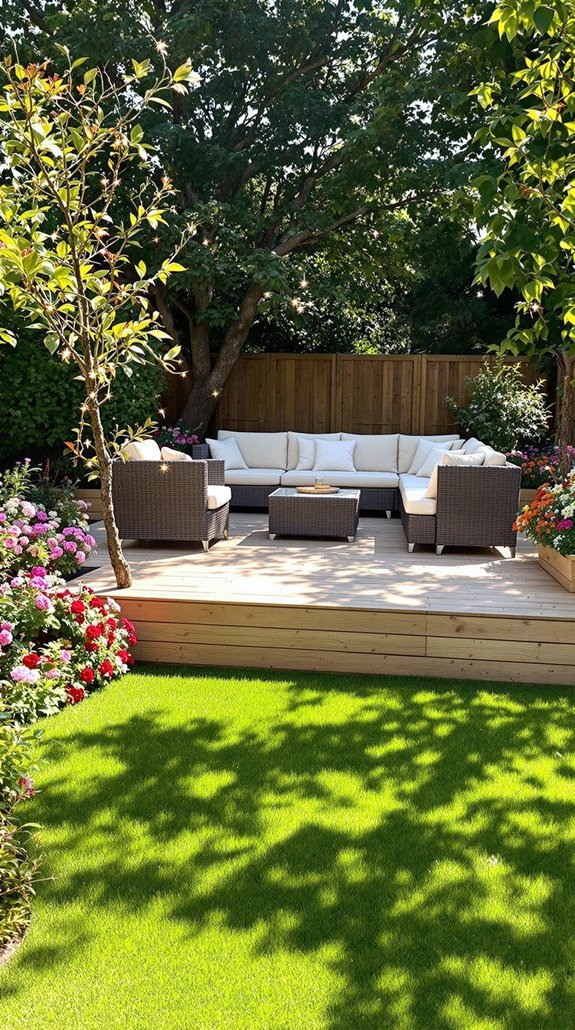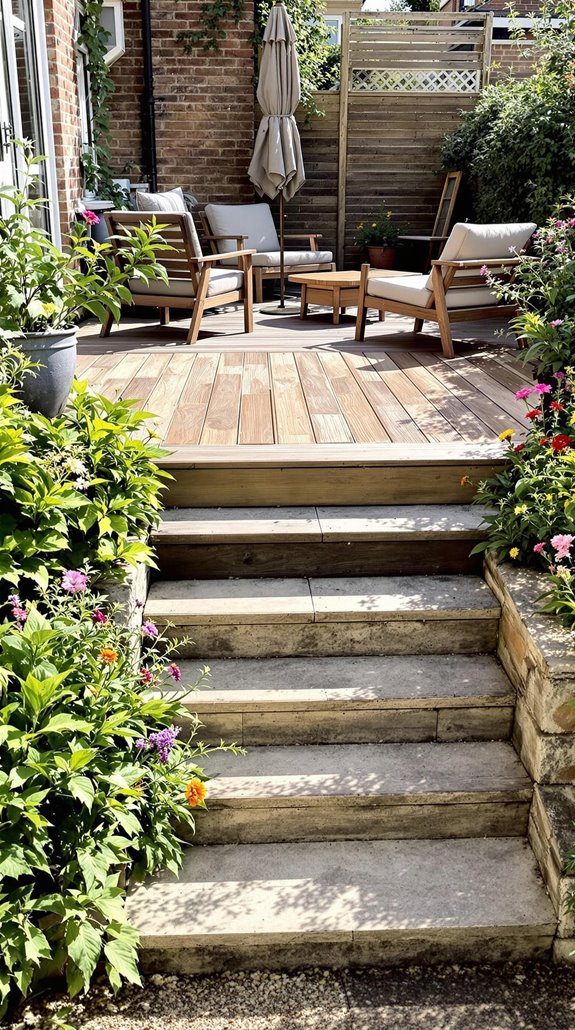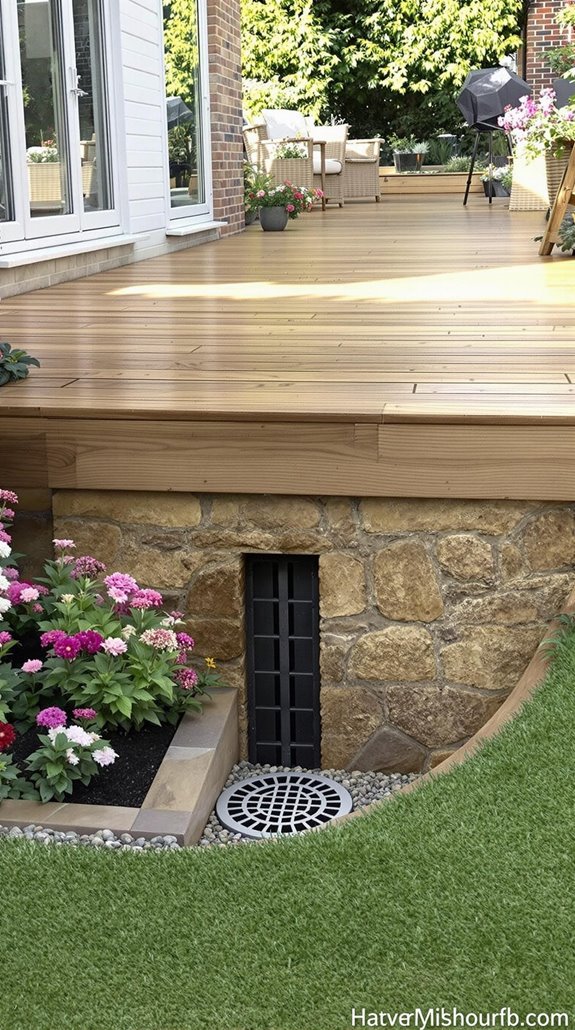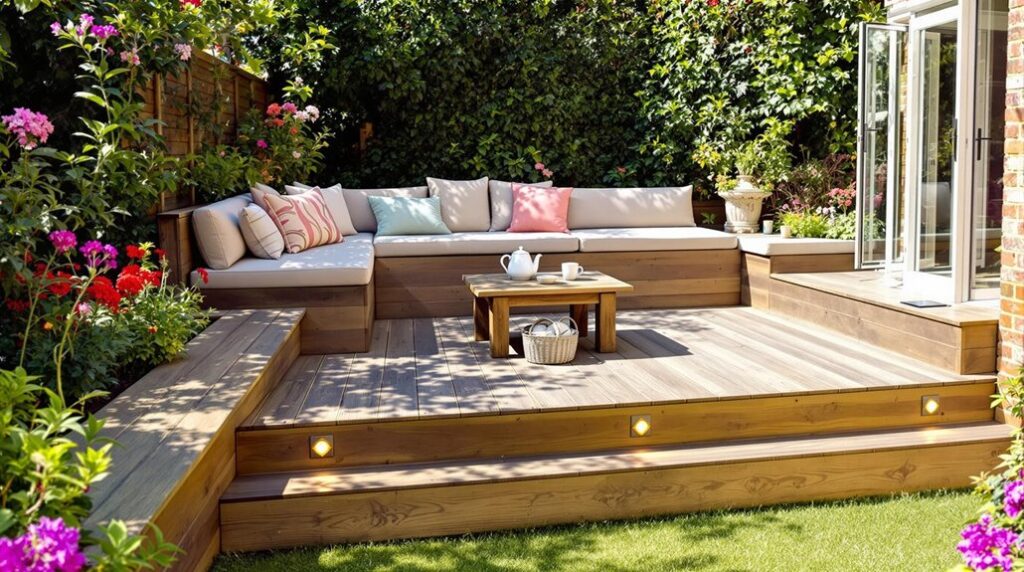I’ve helped dozens of UK homeowners transform their gardens with raised patios that don’t drain their savings accounts. The key isn’t expensive materials or fancy contractors—it’s understanding which design choices actually matter for our unpredictable British weather and clay-heavy soils. Most people make three critical mistakes that’ll cost them hundreds in repairs within two years, but there’s a straightforward approach that’ll give you professional results at a fraction of the price.
Key Takeaways
- Choose budget-friendly materials like reclaimed wooden pallets, old bricks, or Indian limestone to reduce costs by 15-20%.
- Start with a manageable 5x5m core design to keep initial investment low while creating maximum impact.
- Handle DIY site preparation yourself to save £200-£300 in labour fees before professional installation.
- Select concrete patios at £65-£120 per square meter for excellent value without compromising on durability.
- Hire general labourers instead of landscape gardeners for more cost-effective professional assistance when needed.
Why Raised Patios Are Perfect for UK Gardens

When you’re planning your next garden upgrade, raised patios offer exceptional value for UK properties by addressing our unique environmental challenges head-on. I’ve found that elevated designs prevent waterlogging on uneven terrain that’s common across UK regions, whilst the average garden size of 188m² suits tiered patios perfectly for efficient zoning. Additionally, these extensions can significantly boost property value by enhancing the overall appeal of your home.
You’ll create superior flood mitigation through better water percolation, especially when using permeable materials like gravel infill that align with sustainable drainage systems. The elevated foundations tackle our high-rainfall climate effectively, and you can use repurposed materials like railway sleepers to reduce construction costs markedly.
With 22% of gardeners reducing lawns for hardscaping, you’re joining a growing movement that maximizes small urban plots without sacrificing essential greenery for wildlife-friendly gardens. These raised patio designs perfectly complement the trend toward outdoor living spaces that include dining areas and entertainment zones for year-round enjoyment.
Popular Design Styles That Transform Your Outdoor Space
As you select your raised patio design, the style you choose will determine both your construction costs and long-term maintenance requirements. Modern minimalist designs use concrete and slate with geometric shapes, keeping expenses predictable through clean lines and monochromatic schemes. Traditional British styles feature natural Yorkstone or Cotswold stone in classic herringbone patterns, paired with brick edging for authentic charm. Multi-level terraced layouts work brilliantly for sloping gardens, creating functional zones connected by stone staircases. Rustic aesthetics combine weathered limestone with irregular edges for organic texture that ages beautifully. Mediterranean styles bring luxury elements through terracotta tiles and mosaic details that create stunning visual focal points. Each style can significantly influence your garden’s overall value, making it essential to select one that complements your home’s design. Entertainment-focused designs prioritize spacious layouts with built-in barbecues and flexible seating. Each style offers distinct cost implications, so I’ll help you match your vision with your budget constraints.
Budget-Friendly Material Options for Every Garden

Smart material choices can slash your raised patio costs by up to 60% without compromising durability or visual appeal.
I’ve found reclaimed wooden pallets offer the best bang for your buck – they’re often free and you can customize them with paint or stain. Old bricks create that classic look we all love, perfect for traditional patterns and edging.
For natural stone enthusiasts, Indian limestone delivers deep black tones when wet at budget prices. Autumn Brown Sandstone blends beautifully with rural settings while providing natural slip resistance. Wall blocks are an excellent alternative that creates a natural stone appearance while requiring minimal maintenance over time.
Don’t overlook concrete options like Hardstone slabs from £24.33/m² – they’re uniform sizing simplifies installation. Gravel remains the cheapest choice, offering excellent drainage and DIY-friendly installation for irregularly shaped areas.
Essential Construction Considerations for Long-Lasting Results
Building a raised patio that’ll stand the test of time requires meticulous attention to structural fundamentals—skip these steps and you’ll face costly repairs within five years.
I’ll start with foundations—your most critical investment. Dig below the frost line plus 150mm, then compact your base trench twice using a plate compactor. Install 150mm of crushed stone sub-base with landscape fabric underneath to prevent weeds and soil migration.
For retaining walls over 600mm height, you’ll need engineered designs to handle lateral soil pressure. Calculate base trench depth by adding 25mm per 300mm of wall height. Install perforated drain pipes behind walls, vented to daylight—water buildup destroys everything. Check for alignment and levelness regularly during construction to ensure structural integrity.
Use C16/C24 strength-graded timber for structural elements and galvanized steel brackets for beam connections. These fundamentals guarantee your patio survives decades.
Cost-Effective Implementation Strategies to Maximize Your Budget
While solid foundations form your patio’s backbone, strategic cost management determines whether you’ll spend £1,200 or £4,000 on the same project. I’ve found that choosing concrete patios at £65-£120 per sq m delivers excellent value without compromising durability. You’ll save considerably by hiring general labourers at £200/day instead of landscape gardeners at £550/day for basic installations.
I recommend starting with a 5x5m core design, keeping costs between £1,200-£3,250, then expanding later. Rectangular layouts minimize cutting waste, while DIY site preparation saves £200-£300 in labour fees. For equipment needs, budget for essential tools like cement mixers at £30-£50 daily rental rates. Additionally, understanding regional price variations can help you further refine your budget and expectations based on your location. Source reclaimed materials for 15-20% savings, and schedule work during off-peak seasons for contractor discounts. Smart phasing lets you build affordably while maintaining quality standards.
Multi-Level Patio Designs for Visual Impact
Creating multiple patio levels transforms flat outdoor spaces into dynamic landscapes that command attention and maximize functionality. I’ll show you how to achieve stunning visual impact without breaking your budget.
Start with unified materials—extend identical patterned tiles across all levels for seamless cohesion. Use Granite Eclipse Steps or Casarta Steps to connect tiers while creating natural barriers. Position dining areas on raised terraces and sink lounging zones lower for functional separation.
Frame level changes with oversized concrete planters filled with structural shrubs like boxwood. Install gabion walls with locally sourced stone as organic dividers—they’re cost-effective and striking. Add pergolas above upper decks to define entertainment spaces.
Center fire pits on lower platforms to draw focus across multi-level sightlines, creating gathering spots that anchor your tiered design beautifully. Strategic uplighting reveals plant textures and creates enchanting visual effects that highlight your carefully planned level changes.
Drainage Solutions That Work in British Weather

Multi-level patios look spectacular until Britain’s unpredictable weather turns poor drainage into a costly nightmare. I’ll show you drainage solutions that actually work without breaking your budget.
Channel drains are your best friend for raised patios. Install them at the lowest points with 100mm backfill space and concrete them on a 50mm aggregate base. Position grates slightly below surface level – this captures water before it pools. Conducting a drainage survey before installation can help identify any existing drainage issues that may affect your patio.
For clay soil gardens like mine, you’ll need soakaways or pump stations since water won’t drain naturally. French drains redirect subsurface water away from foundations, whilst gravel paths double as hidden drainage routes. Standing water can cause structural problems by eroding the sub-base beneath your patio slabs.
Always maintain 1:100 fall gradients and use load-rated grates that’ll survive freeze-thaw cycles. Check local regulations before connecting to mains drainage.
Entertainment Features That Enhance Your Outdoor Living
Transform your raised patio into Britain’s ultimate outdoor entertainment hub with features that’ll keep you hosting year-round.
I’ll prioritize seating first—modular sofas and built-in benches accommodate guests comfortably while weather-resistant rattan and powder-coated aluminum guarantee durability. Add outdoor dining sets for dedicated meal areas.
Next, lighting creates ambiance. String lights provide festive atmosphere, while LED strips and solar-powered lanterns offer adjustable illumination. Spotlight-lined staircases add drama to multi-level designs.
Heating extends usage beyond summer. Fire pits serve as heat sources and social gathering points, while outdoor heaters provide targeted warmth. Wood storage areas built into your raised patio design ensure convenient access to fuel for fire features.
Finally, create zones with split-level designs and raised planters as borders. Louvred roof pergolas with adjustable slats protect from sun and rain, while integrated lighting and heating maximize comfort regardless of weather.
DIY Vs Professional Installation: Making the Right Choice
Should you tackle your raised patio installation yourself or hire professionals? I’ll help you weigh the options based on your budget and skills.
Cost breakdown: DIY materials cost £1–£35 per sq. ft., while professional installation adds £10–£50 per sq. ft. in labour. For a 20m² patio, you’ll save £1,080–£2,160 by going DIY, but factor in potential 15–20% material wastage and £100–£200 waste disposal costs.
Time investment: Professionals complete a 20m² patio in 3–4 days, while DIYers need 3–10 days depending on experience.
Risk assessment: DIY structural flaws can cost £500–£1,000 in future repairs, while professionals offer 5–10 year warranties and increase resale value by 5–10%. Garden access issues can also significantly increase installation time and labour costs for both DIY and professional projects.
Choose DIY for simple designs and tight budgets, professionals for complex elevated structures.
Maintenance Tips to Keep Your Raised Patio Looking Great
Once you’ve invested in your raised patio, proper maintenance becomes essential for protecting that investment and ensuring years of enjoyment. I’ll share the key practices that keep costs down while maximizing longevity.
Weekly sweeping removes debris before it causes stains, focusing on high-traffic areas first. Clear autumn leaves promptly—they create permanent discoloration when left decomposing. For spills, I act within minutes using appropriate cleaners tested on hidden spots first. Never use acid-based products on limestone or sensitive stones. Additionally, using high-impact areas like patios for renovations can enhance the overall appeal of your garden.
Quarterly inspections catch structural issues early. I check for cracks, loose slabs, and joint damage, addressing problems before weather worsens them. A yard brush with stiff bristles effectively removes stubborn debris and eliminates lichen and moss buildup. Seasonal tasks include spring deep-cleaning for algae, summer spill management, autumn leaf control, and winter snow clearing with patio-safe de-icers.
Conclusion
I’ve shown you how raised patios can transform your UK garden without draining your wallet. You’ll save hundreds by choosing reclaimed materials and tackling DIY installation yourself. Don’t forget proper drainage—it’s vital for our unpredictable weather. Start with a simple design, focus on solid foundations, and add features gradually as your budget allows. With careful planning and smart material choices, you’ll create a stunning outdoor space that’ll last for years.
References
- https://www.mybuilder.com/carpentry-joinery/articles/raised-patio-ideas
- https://www.homebuilding.co.uk/ideas/raised-patio-ideas
- https://www.marshalls.co.uk/gardens-and-driveways/blog/garden-patio-ideas-for-large-spaces
- https://davieslandscapes.co.uk/raised-patio-ideas-uk/
- https://www.minsterpaving.co.uk/the-best-garden-patio-ideas-to-try/
- https://www.rhs.org.uk/science/pdf/increasing-environmental-resilience-of-gardens.pdf
- https://pavingshopper.co.uk/blogs/news/uk-garden-statistics-and-trends-2024
- https://cy.ons.gov.uk/economy/environmentalaccounts/bulletins/healthbenefitsfromrecreationnaturalcapitaluk/2022
- https://www.cladcodecking.co.uk/blog/post/uk-gardening-statistics
- https://hta.org.uk/news/gardening-is-nature-s-gym-as-81-of-adults-agree-gardens-benefit-their-physical-health/

